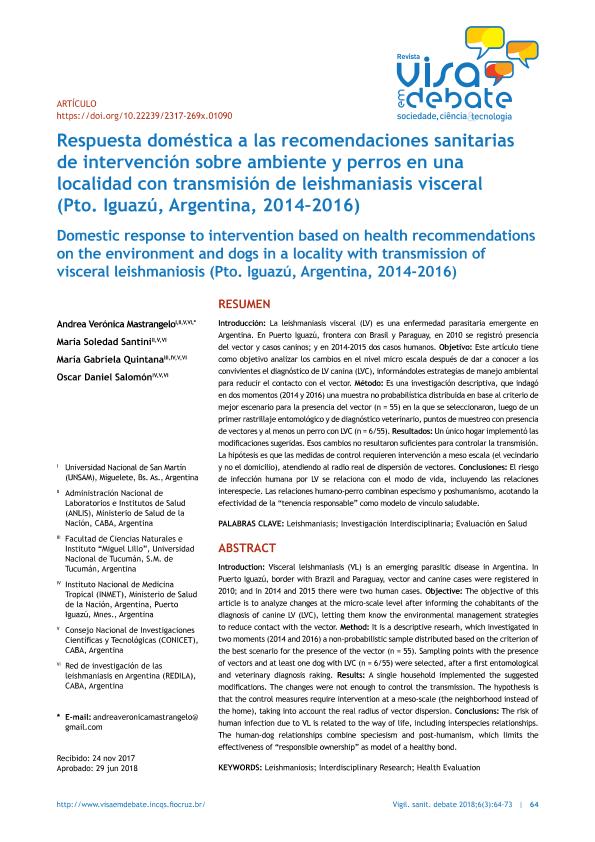Artículo
La leishmaniasis visceral (LV) es una enfermedad parasitaria emergente enArgentina. En Puerto Iguazú, frontera con Brasil y Paraguay, en 2010 se registró presencia del vector y casos caninos; y en 2014-2015 dos casos humanos. Objetivo: Este artículo tiene como objetivo analizar los cambios en el nivel micro escala después de dar a conocer a los convivientes el diagnóstico de LV canina (LVC), informándoles estrategias de manejo ambiental para reducir el contacto con el vector. Método: Es una investigación descriptiva, que indagó en dos momentos (2014 y 2016) una muestra no probabilística distribuida en base al criterio de mejor escenario para la presencia del vector (n = 55) en la que se seleccionaron, luego de un primer rastrillaje entomológico y de diagnóstico veterinario, puntos de muestreo con presencia de vectores y al menos un perro con LVC (n = 6/55). Resultados: Un único hogar implementó las modificaciones sugeridas. Esos cambios no resultaron suficientes para controlar la transmisión.La hipótesis es que las medidas de control requieren intervención a meso escala (el vecindario y no el domicilio), atendiendo al radio real de dispersión de vectores. Conclusiones: El riesgo de infección humana por LV se relaciona con el modo de vida, incluyendo las relaciones interespecie. Las relaciones humano-perro combinan especismo y poshumanismo, acotando la efectividad de la tenencia responsable como modelo de vínculo saludable. Introduction: Visceral leishmaniasis (VL) is an emerging parasitic disease in Argentina. In Puerto Iguazú, border with Brazil and Paraguay, vector and canine cases were registered in 2010; and in 2014 and 2015 there were two human cases. Objective: The objective of this article is to analyze changes at the micro-scale level after informing the cohabitants of the diagnosis of canine LV (LVC), letting them know the environmental management strategies to reduce contact with the vector. Method: It is a descriptive researh, which investigated in two moments (2014 and 2016) a non-probabilistic sample distributed based on the criterion of the best scenario for the presence of the vector (n = 55). Sampling points with the presence of vectors and at least one dog with LVC (n = 6/55) were selected, after a first entomological and veterinary diagnosis raking. Results: A single household implemented the suggested modifications. The changes were not enough to control the transmission. The hypothesis is that the control measures require intervention at a meso-scale (the neighborhood instead of the home), taking into account the real radius of vector dispersion. Conclusions: The risk of human infection due to VL is related to the way of life, including interspecies relationships. The human-dog relationships combine speciesism and post-humanism, which limits the effectiveness of “responsible ownership” as model of a healthy bond.
Respuesta doméstica a las recomendaciones sanitarias de intervención sobre ambiente y perros en una localidad con transmisión de leishmaniasis visceral (Pto. Iguazú, Argentina, 2014–2016)
Título:
Domestic response to intervention based on health recommendations on the environment and dogs in a locality with transmission of visceral leishmaniosis (Pto. Iguazú, Argentina, 2014-2016)
Mastrangelo, Ana Verónica; Santini, Maria Soledad ; Quintana, María Gabriela
; Quintana, María Gabriela ; Salomón, Oscar Daniel
; Salomón, Oscar Daniel
 ; Quintana, María Gabriela
; Quintana, María Gabriela ; Salomón, Oscar Daniel
; Salomón, Oscar Daniel
Fecha de publicación:
08/2018
Editorial:
Fundação Oswaldo Cruz
Revista:
Vigilância Sanitária em Debate
ISSN:
2317-269X
Idioma:
Español
Tipo de recurso:
Artículo publicado
Clasificación temática:
Resumen
Palabras clave:
Leishmanisis
,
Investigacion Interdisciplinaria
,
Evaluacion en Salud
Archivos asociados
Licencia
Identificadores
Colecciones
Articulos(CCT - NOA SUR)
Articulos de CTRO.CIENTIFICO TECNOL.CONICET - NOA SUR
Articulos de CTRO.CIENTIFICO TECNOL.CONICET - NOA SUR
Citación
Mastrangelo, Ana Verónica; Santini, Maria Soledad; Quintana, María Gabriela; Salomón, Oscar Daniel; Respuesta doméstica a las recomendaciones sanitarias de intervención sobre ambiente y perros en una localidad con transmisión de leishmaniasis visceral (Pto. Iguazú, Argentina, 2014–2016); Fundação Oswaldo Cruz; Vigilância Sanitária em Debate; 6; 3; 8-2018; 64-73
Compartir
Altmétricas



